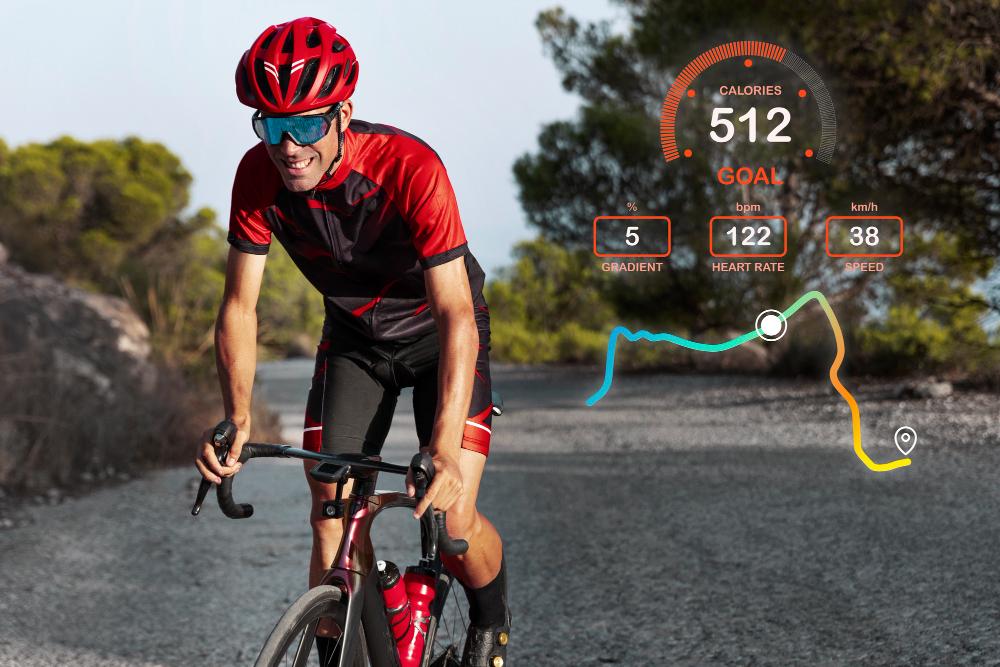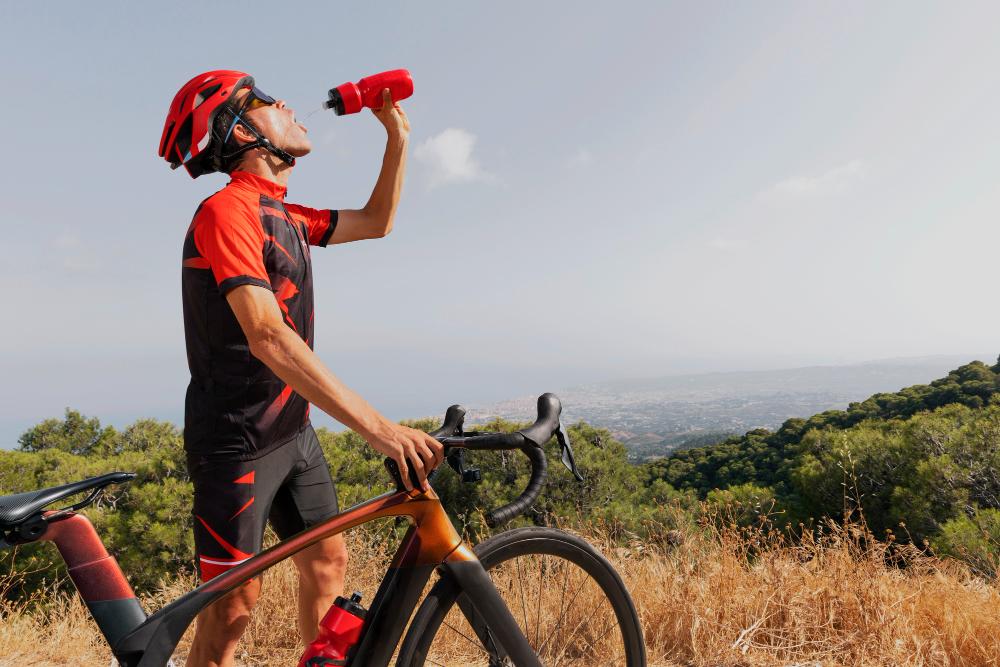Optimizing Cardiorespiratory Efficiency in Cycling: Integrated Strategies to Reduce Heart Rate
Cycling, in addition to being a pleasurable recreational activity, is an extraordinary way to promote cardiovascular health and physical endurance.
As enthusiasts and athletes seek to improve their performance, there is a need for strategies that optimize cardiorespiratory efficiency, contributing not only to more vigorous pedals, but also to reduce the heart rate during efforts.
This article explores a comprehensive set of practices and techniques, from aerobic resistance training to controlled breathing strategies, interval training, muscle strengthening, effective hydration and adequate recovery.
Let’s dive into the nuances of these integrated strategies, aiming not only to improve cycling performance, but also the promotion of robust and sustainable cardiovascular health.
The Vital Importance of Taking Care of Heart Health while Cycling
The heart, the tireless engine of our circulatory system, plays a critical role in the success and well-being of cyclists of all levels.
As we explore strategies to optimize cardiorespiratory efficiency in cycling, It is imperative to highlight the extreme importance of taking care of your heart health.
This vital organ is not just the conductor of our pedal strokes, but also the epicenter of our overall health.
When cycling, the heart works tirelessly to deliver oxygen and nutrients to working muscles.
In this context, aerobic resistance training, as will be discussed in section 1, emerges as a fundamental tool.
By strengthening cardiovascular capacity, we reduce the load on the heart during prolonged efforts, promoting more efficient blood circulation.
However, heart health goes beyond physical training.
Proper hydration (section 5) is essential for maintaining optimal blood volume and viscosity, ensuring that the heart does not have to work harder than necessary.
In the same way, attention to recovery (section 6) is crucial to avoid excessive cardiovascular stress, allowing the heart to rest and recover after the demands of cycling.
When implementing training strategies, controlled breathing, muscle strengthening and all other techniques presented in this article, we are, ultimately, investing in the long-term health of our vital organ.
A healthy heart not only boosts our cycling performance, but it is a safeguard for an active and vibrant life.
So, when seeking excellence in cycling, let us remember that taking care of our heart is the cornerstone to conquering not just kilometers on the road, but a full and energized life.
Aerobic Endurance Training:
Aerobic resistance training is essential for improving cardiovascular efficiency and lowering heart rate during cycling..
It focuses on developing the cardiovascular system's ability to deliver oxygen to muscles effectively.
Here is some additional information:
Training Zones:
- Many athletes use training zones to control the intensity of their workouts.. The area 2, also known as the aerobic zone, is often mentioned in this context.
- This zone represents a moderate intensity, where the heart rate is high enough to stimulate the cardiovascular system, but still allows you to comfortably carry on a conversation.
- When carrying out long-term training in this zone, you are promoting physiological adaptations that improve the body's ability to transport oxygen and nutrients to the muscles.
Long-Term Training:
- Aerobic endurance training often involves longer sessions of cycling at a sustainable pace..
- The duration of these workouts may vary, but generally involve periods of 60 minutes or more, depending on the cyclist's fitness level.
Mitochondrial Effect:
- Aerobic training stimulates an increase in mitochondrial density in muscle cells. Mitochondria play a crucial role in aerobic energy production.
- Over time, this contributes to greater energy efficiency and can result in a reduction in heart rate at submaximal efforts.
Heart Rate Monitoring:
- Using a heart rate monitor during your workouts is a valuable tool for ensuring you stay within your desired training zone..
- Monitoring heart rate over time can also provide insights into cardiovascular adaptations and training progress..
By consistently incorporating aerobic resistance training into your cycling routine, you will be strengthening your cardiovascular system and helping to reduce your heart rate during pedaling, resulting in more efficient and sustainable performance.
2. Interval Training:
Interval training is an effective strategy for improving cardiovascular capacity, increase the efficiency of the cardiovascular system and reduce heart rate while pedaling.
This method involves alternating between periods of intense effort and periods of recovery.. Here are additional details about interval training:
Variety of Protocols:
- There are several interval training protocols, each with its specific benefits. Examples include Tabata workouts (20 seconds of intense effort, followed by 10 seconds of rest), HIIT intervals (High-Intensity Interval Training) and pyramid training, in which the intensity varies over time.
Cardiovascular Stimulation:
- High-intensity intervals stimulate the heart to work harder, promoting cardiovascular adaptations. This includes an increase in the heart's pumping capacity and better distribution of blood to working muscles..
Reducing Heart Rate at Rest:
- Although it may seem contradictory, Frequent interval training has been shown to reduce resting heart rate over time. This suggests a positive adaptation of the cardiovascular system, allowing the heart to be more efficient during periods of rest.
Greater Efficiency of the Cardiovascular System:
- Interval training helps increase the efficiency of the cardiovascular system, improving the body's ability to deal with variations in oxygen demand. This can result in a faster, more controlled heart rate response during physical activities..
Metabolic Adaptations:
- In addition to the cardiovascular benefits, interval training also triggers metabolic adaptations, such as improving aerobic capacity and optimizing energy use by muscles.
Safe Inclusion in Training Programs:
- It is important to adapt interval training to your physical condition and goals.. Starting with shorter, less intense sessions and progressively increasing the difficulty can help avoid injuries and allow for gradual adaptation..
By properly and progressively incorporating interval training into your cycling routine, you can significantly improve the efficiency of the cardiovascular system, promoting positive adaptations that, long-term, will contribute to reducing heart rate during pedaling and to a performance more sustainable.
3. Strength Training:
Strength training plays a crucial role in improving mechanical efficiency during cycling, what, in turn, can contribute to reducing heart rate while pedaling.
Here are additional details on how strength training can be beneficial:
Muscle Development:
- Strength training aims to strengthen the muscles used during cycling, like the quadriceps, hamstrings, glutes and lower back muscles.
- Stronger muscles can perform work more efficiently, reducing the load on the cardiovascular system.
Improved Mechanical Efficiency:
- By strengthening the specific muscle groups involved in cycling, you can improve the mechanical efficiency of the pedal. This means that each pedal stroke generates more power, reducing the need for excessive cardiac effort to maintain a given rhythm.
Injury Prevention:
- Strength training also plays an important role in preventing injuries. Strengthening the muscles around your joints can help stabilize those joints., reducing the risk of cycling-related injuries.
Variety of Exercises:
- Include a variety of exercises in your strength training, like squats, deadlift, specific exercises for the lower back and stabilization exercises.
- Functional movements that mimic pedal action are also beneficial for strengthening muscles used in cycling.
Proper Programming:
- Balance your strength training with cycling days. This could involve strength training sessions on days you're not cycling, or incorporating specific strength exercises after cycling sessions..
Consistency and Progression:
- Consistency is key to seeing improvements in strength training. Gradually, increase the intensity, the volume or complexity of exercises to promote continued strength gains.
By integrating strength training in a balanced way into your cycling training program, you not only strengthen the muscles fundamental to performance, but also contributes to improved mechanical efficiency, which can result in a reduction in heart rate while pedaling.
4. Controlled Breathing:
The practice of breathing techniques controlled during cycling can play a significant role in reducing heart rate, promoting calm and respiratory efficiency.
Here are some additional details about the importance of controlled breathing:
Diaphragmatic Breathing:
- Diaphragmatic breathing, also known as abdominal breathing, It is essential for calming the nervous system and optimizing gas exchange in the lungs.
- Involves expansion of the diaphragm during inspiration, allowing the lungs to fill completely with air.
Breathing Patterns:
- While cycling, It is common for breathing to become rapid and shallow, especially in moments of intense effort.
- Practicing awareness and modification of breathing patterns can help maintain a calmer, more efficient rhythm..
Synchronized Rhythm:
- Synchronizing your breathing with your pedaling motion can be beneficial. For example, Taking a deep breath during the extension phase and a controlled exhale during the compression phase can help maintain a steady rhythm.
Relaxation Techniques:
- Incorporate relaxation techniques, like deep, slow breathing, May decrease the body's response to stress.
- A popular technique is breathing 4-7-8, where you breathe in through your nose counting to 4, hold your breath for 7 seconds and exhale through the mouth counting until 8 seconds.
Focus on Exhalation:
- Emphasizing full exhalation is crucial. Often, we focus on inspiration, but a full exhale removes accumulated carbon dioxide and prepares the lungs for the next inhalation.
Regular Practice:
- Regular practice of these techniques, not just during the pedals, but also in moments of relaxation and recovery, can condition the body to maintain more effective breathing patterns even under stress.
By incorporating controlled breathing as an integral part of your cycling training, you can not only positively influence the nervous system response, but also contribute to reducing heart rate, promoting a state of calm and control while pedaling.
5. Adequate Hydration:
Hydration plays a crucial role in regulating heart rate during cycling.
Staying well hydrated is essential for cardiovascular performance and can directly influence the heart's response to physical exertion..
Here are additional details on the importance of adequate hydration:
Cardiovascular Function:
- Water is an essential component for effective cardiovascular function. Dehydration can lead to a reduction in blood volume, increasing blood viscosity and requiring greater effort from the heart to pump blood.
Body Temperature Control:
- While cycling, especially in warmer climates, sweating is a natural response to dissipate body heat. Dehydration can compromise the body's ability to regulate temperature, resulting in an increased heart rate.
Blood Volume Maintenance:
- Water is a significant component of blood. Dehydration can reduce blood volume, which can lead to an increase in heart rate to maintain adequate oxygen and nutrient supply to the muscles.
Effect on Performance:
- Dehydration can compromise performance, leading to faster fatigue and an increase in perceived exertion. Right, in turn, may result in a higher cardiac response.
Hydration Strategies:
- It is important to plan hydration strategies before, during and after cycling. Drinking water regularly during exercise helps maintain adequate fluid and electrolyte balance.
Headquarters Monitoring:
- Thirst is an important indicator of the need for hydration. Not waiting until you feel thirsty to drink water is a recommended practice, as thirst can be a sign of initial dehydration.
Supplementation and Electrolytes:
- In prolonged or intense cycling sessions, electrolyte replacement may be necessary to maintain fluid and electrolyte balance. Sports drinks or supplements may be helpful in these situations.
Environmental conditions:
- The amount of water required may vary depending on weather conditions. In warmer climates, sweating increases, requiring greater fluid intake.
By prioritizing adequate hydration as an integral part of your cycling training regimen, you are not only promoting cardiovascular health, but also contributing to maintaining a more controlled heart rate during the pedals, thus optimizing performance and efficiency.
6. Proper Recovery:
Recovery plays a vital role in reducing heart rate during cycling rides.
An effective recovery plan not only makes it easier for the body to adapt to training efforts, but also contributes to improving cardiovascular efficiency.
Here are additional details on the importance of proper recovery:
Supercompensation Process:
- During training, especially in intense sessions, the body suffers micro-injuries to the muscles and experiences a level of fatigue. The recovery phase is where supercompensation occurs, resulting in stronger muscles and a more efficient cardiovascular response.
Quality Sleep:
- Sleep is an essential component of recovery. During deep sleep, important muscle repair processes and release of growth hormones occur, contributing to the restoration of the body.
Proper Nutrition:
- A adequate nutrient intake, including carbohydrates to replenish muscle glycogen and proteins for muscle repair, is crucial for effective recovery.
Active Recovery Activities:
- Active recovery activities, like gentle stretches, yoga, or a light cycle, can promote blood circulation, helping to remove by-products of metabolism and reducing muscle tension.
Hydration and Electrolyte Replacement:
- After a workout, ensuring adequate hydration and electrolyte replacement is essential to reestablish water balance and prevent fatigue.
Appropriate Rest Periods:
- Including rest days or light training in your schedule is crucial.. Excessive training can lead to an increased resting heart rate and an inadequate cardiovascular response.
Massage and Recovery Therapies:
- Massages and recovery therapies, like myofascial release, can help reduce muscle tension, improve flexibility and speed up the recovery process.
Listen to the Body:
- Paying attention to your body’s signals is essential. If you experience persistent fatigue, pain or an elevated resting heart rate, may be a sign that recovery is not adequate.
By incorporating proper recovery practices into your training routine, you allow the body to adapt positively to the stimuli of cycling, what, in turn, can lead to a reduction in heart rate while pedaling, contributing to more efficient and sustainable performance.
“The Path to a Harmonious Cardiorespiratory Journey”
As we explore multifaceted strategies for optimizing cardiorespiratory efficiency in cycling, we are faced with an intriguing and enriching panorama.
Each element covered – from aerobic resistance training to controlled breathing techniques, interval training, muscle strengthening, effective hydration and adequate recovery – contributes not only to pedaling performance, but for overall heart health.
1. Aerobic Endurance Training:
We discovered that prolonged cycling in moderate zones not only increases our endurance, but also builds a robust cardiovascular foundation.
An efficiently trained heart allows us to face longer challenges with a more balanced heart rate.
2. Interval Training:
The intervals, with its intensity peaks and recovery periods, become powerful allies in improving cardiovascular response.
Our heart's ability to adapt to variations in effort contributes to a more responsive heart rate.
3. Strength Training:
Muscle strengthening proves to be a key, not just in pedaling power, but also in reducing stress on the heart.
Stronger muscles mean more efficient oxygen utilization, relieving cardiovascular load.
4. Controlled Breathing:
Controlled breathing techniques emerge as a harmonious instrument, synchronizing our heart rate with gentle breathing patterns.
The balance between inhalation and exhalation contributes to serenity and a reduction in heart rate while pedaling..
5. Adequate Hydration:
Careful fluid intake proves to be a vital lineage in maintaining water balance and supporting the heart.
Effective hydration maintains blood flow, reducing the need for a high heart rate.
6. Proper Recovery:
We conclude that recovery is the final symphony in the opera of cardiovascular performance.
Restorative sleep, Proper nutrition and the necessary break are synonymous with a renewed heart, ready to take on new rides.
Ultimately, this cardiorespiratory journey transcends the search for improvement in cycling; is a commitment to health and vitality.
By applying these integrated strategies, we don't just transform our pedals, but we cultivate a lasting foundation for a resilient heart and an active life.
The path to a harmonious cardiorespiratory journey is, undoubtedly, an invitation to celebrate every beat, propelling us beyond the roads and toward a full, energized life.
Let's pedal, not just looking for distances, but towards vibrant and sustainable cardiovascular health.
expensive cyclist, Your perspective is valuable to us! After exploring the strategies addressed to optimize cardiorespiratory efficiency in cycling, we invite you to share your experiences and insights.
Which of the topics did you find most intriguing or applicable to your own training?? Be it aerobic resistance training, controlled breathing techniques, or the importance of muscle strengthening, we want to hear your opinion.
Leave your comments below and join this enriching conversation about health, performance and passion for cycling!


More about:
News and Entertainment.











In my research, as 10 main reasons for the heart to speed up too much:
1. Physical exercise: During physical activities, the body demands more oxygen and nutrients, leading to an increase in heart rate to deliver these resources more efficiently.
2. Stress or anxiety: Stressful or anxious situations can trigger a sympathetic nervous system response, leading to an increase in heart rate as part of the “fight or flight”.
3. Fever: The increase in body temperature associated with fever can lead to an increase in heart rate.
4. Dehydration: Lack of fluids in the body can decrease blood volume, causing the heart to beat faster to maintain adequate oxygen and nutrient supply.
5. Thyroid Problems: Thyroid disorders, such as hyperthyroidism, can affect metabolism and cause tachycardia.
6. Stimulants: Caffeine consumption, Nicotine or other stimulants can speed up your heart rate.
7. Heart problems: Heart diseases, like arrhythmias, heart valve disease or heart failure, can lead to an increase in heart rate.
8. Anemia: A lack of red blood cells or hemoglobin in the blood can result in the heart working harder to compensate for reduced oxygen transport..
9. Medicines: Certain medications, as decongestants, bronchodilators and some antidepressants, may cause an increase in heart rate as a side effect.
10. Genetic factors: Some people may have a genetic predisposition to tachycardia or other heart problems.
———-
If you consider that it could be the coffee, you can stop consuming it for some time to test. The time it takes to notice a change in heart rate after stopping drinking coffee may vary from person to person.. Generally, the effects of caffeine begin to wear off within a few hours after the last intake. However, The body's full adaptation to the effects of caffeine withdrawal may take a few days to a few weeks. If you are a regular caffeine consumer and decide to stop, You may experience some withdrawal symptoms, like headaches, irritability and fatigue in the first few days. Your heart rate may also gradually decrease as your body adjusts to the absence of the substance..
It's worth the test, hein?!